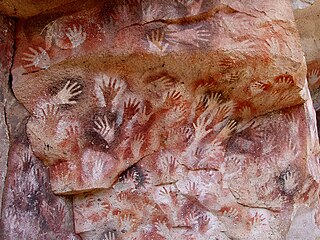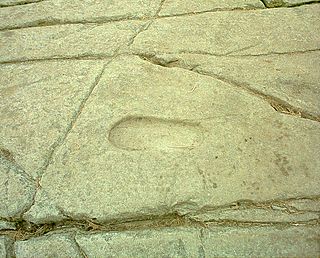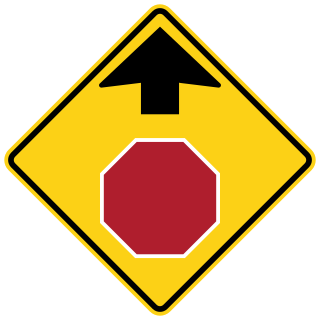 W
WIn archaeology, rock art is human-made markings placed on natural surfaces, typically vertical stone surfaces. A high proportion of surviving historic and prehistoric rock art is found in caves or partly enclosed rock shelters; this type also may be called cave art or parietal art. A global phenomenon, rock art is found in many culturally diverse regions of the world. It has been produced in many contexts throughout human history. In terms of technique, the main groups are: petroglyphs, which are carved or scratched into the rock surface, cave paintings, and sculpted rock reliefs. Another technique creates geoglyphs that are formed on the ground. The oldest known rock art dates from the Upper Palaeolithic period, having been found in Europe, Australia, Asia, and Africa. Anthropologists studying these artworks believe that they likely had magico-religious significance.
 W
WThe Ancient Rock Carvings of Sindh have been explored in Kirthar Mountains Range, Sindh, Pakistan. The Kirthar Mountains Range covers a distance of 190 miles in boundaries of Jacobabad District, Qambar Shahdadkot District, Dadu District and Jamshoro District from north to south up to Karachi, Sindh.
 W
WThe Ballochmyle cup and ring marks were first recorded at Ballochmyle, Mauchline, East Ayrshire, Scotland in 1986, very unusually carved on a vertical red sandstone cliff face, forming one of the most extensive areas of such carvings as yet found in Britain. They have been designated a scheduled monument.
 W
WThe Rock 1 of Bedolina, the so-called Bedolina Map, is a famous engraved prehistoric rock which is part of the Camonica valley petroglyph complex. It is known as being one of the most ancient topographic maps, interpreted as the depiction of cultivated plots, mountain paths and villages. The locality of Bedolina pertains to the Capo di Ponte municipality (BS-I), near the hamlet of Pescarzo. The area is included in the Seradina-Bedolina Archaeologic park, lying on a prominent terrace on the right slope of the Camonica valley, at an altitude of 530 m above the sea level. The rock, a flat surface of Permian sandstone polished by the Pleistocene glacier, is 9 m long and 4 m wide.
 W
WCave paintings are a type of parietal art, found on the wall or ceilings of caves. The term usually implies prehistoric origin, but cave paintings can also be of recent production: In the Gabarnmung cave of northern Australia, the oldest paintings certainly predate 28,000 years ago, while the most recent ones were made less than a century ago.
 W
WColdstream Stone is a small polychrome, painted stone that was found buried with a human skeleton in a rock shelter near the Lottering River in the southern coast of the Western Cape Province in South Africa.
 W
WCup and ring marks or cup marks are a form of prehistoric art found in the Atlantic seaboard of Europe (Ireland, Wales, Northern England, Scotland, France, Portugal, and Spain – and in Mediterranean Europe – Italy and Greece, as well as in Scandinavia and in Switzerland. Two studies published in 2019 found that the population which built Britain's Stonehenge descended predominantly from Fertile Crescent, South Slavic, Anatolian, and Aegean farmers, and while female lineages were varied, male lineages belonged almost exclusively to Eastern European and Mediterranean males of I2a genetic lineage.
 W
WA geoglyph is a large design or motif produced on the ground and typically formed by clastic rocks or similarly durable elements of the landscape, such as stones, stone fragments, gravel, or earth. A positive geoglyph is formed by the arrangement and alignment of materials on the ground in a manner akin to petroforms, while a negative geoglyph is formed by removing part of the natural ground surface to create differently coloured or textured ground in a manner akin to petroglyphs.
 W
WGobustan Rock Art represents flora and fauna, hunting, lifestyles, and culture of pre-historic and medieval periods of time. The carvings on the rocks illustrates primitive men, ritual dances, men with lances in their hands, animals, bull fights, camel caravans, and picture of the sun and stars. The date of these carvings goes back to 5.000 – 20.000 years before.
 W
WThe Newspaper Rock Petroglyphs Archeological District is part of the Petrified Forest National Park, and contains in excess of 650 petroglyphs, believed to have been created 1499-1000 AD. This Apache County site near Adamana, Arizona was listed on the National Register of Historic Places July 12, 1976.
 W
WPecked curvilinear nucleated, (PCN) in archaeology, is a form of prehistoric rock carving. The term was originally proposed by Teresa Miller and Reed Haslam in 1976 to describe a widespread type of rock carving in western North America. The form is characterized by a circular or oval groove element, which results in a raised center area. The form is quite prevalent in California and is applied to a number of Native American rock carving sites in this portion of the United States.
 W
WA petroglyph is an image created by removing part of a rock surface by incising, picking, carving, or abrading, as a form of rock art. Outside North America, scholars often use terms such as "carving", "engraving", or other descriptions of the technique to refer to such images. Petroglyphs are found worldwide, and are often associated with prehistoric peoples. The word comes from the Greek prefix petro-, from πέτρα petra meaning "stone", and γλύφω glýphō meaning "carve", and was originally coined in French as pétroglyphe.
 W
WA petrosomatoglyph is a supposed image of parts of a human or animal body in rock. They occur all over the world, often functioning as an important form of symbolism, used in religious and secular ceremonies, such as the crowning of kings. Some are regarded as artefacts linked to saints or culture heroes.
 W
WA pictogram, also called a pictogramme, pictograph, or simply picto, and in computer usage an icon, is a graphic symbol that conveys its meaning through its pictorial resemblance to a physical object. Pictographs are often used in writing and graphic systems in which the characters are to a considerable extent pictorial in appearance. A pictogram may also be used in subjects such as leisure, tourism, and geography.
 W
WRock balancing or stone balancing is an art, discipline, or hobby in which rocks are naturally balanced on top of one another in various positions without the use of adhesives, wires, supports, rings or any other contraptions which would help maintain the construction's balance. The number of rock piles created in this manner in natural areas has recently begun to worry conservationists because they can misdirect hikers, expose the soil to erosion, aesthetically intrude upon the natural landscape, and serve no purpose.
 W
WRock cupules are humanly made depressions on rock surfaces that resemble the shape of an inverse spherical cap or dome. They were made by direct percussion with hand-held hammer-stones, on vertical, sloping or horizontal rock surfaces. Cupules are widely believed to be the world's most common rock art motifs, found in huge numbers in every continent except Antarctica. They were produced in many cultures, from the Lower Paleolithic to the 20th century, and they can be found on most lithologies. Similar artifacts from lithic Native American cultures are also known as cupstones.
 W
WIn archaeology, a stone ball or petrosphere is the name for any spherical man-made object of any size that is composed of stone. These mainly prehistoric artifacts may have been created or selected, but altered in some way to perform their specific function, including carving and painting.
 W
W W
W W
W